Air Defense Systems Market Overview: 2031
The global air defense systems market was valued at $46.2 billion in 2021, and is projected to reach $78.2 billion by 2031, growing at a CAGR of 5.6% from 2022 to 2031. Air defense systems include land, aerial, and marine-based technologies used by the defense forces to guard against a variety of missiles, including cruise and ballistic missiles. Amid rise in conflicts and war-like situations across different parts of the world, the demand for air defense systems have grown at a significant rate. Air defense systems ensure the safety of national assets and citizens against missile attacks. With the introduction of more lethal, covert, and nimble enemies, the character of modern warfare has evolved. As the nature of warfare has changed, countries tend to invest in defensive spending; this has resulted in the development of numerous air defense systems. Currently, large defense corporations globally are substantially investing on the development of missile defense systems.
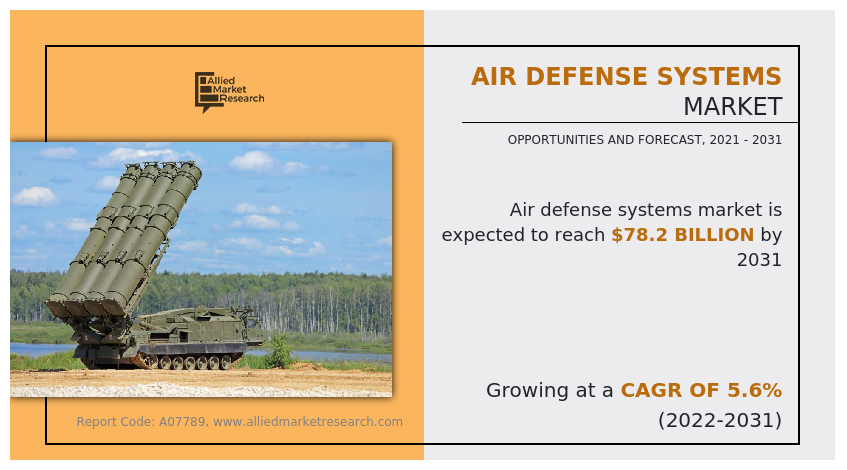
Growth of the air defense system market is driven by factors such as increase in cross border conflicts, technological advancement in weapon system, usage of new age weapons such as drone, and increasing defense budget expenditure are primary factors supporting the air defense systems market growth. The global defense expenditure has seen exponential growth in recent years. According to Stockholm International Peace Research Institute (SIPRI), global defense spending reached $1,981 billion in 2020 with a 2.6% year-on-year increase. The military expenditure accounted for 2.4% of the global gross domestic product (GDP) in 2020. Thus, increase in global military expenditure has augmented the adoption of efficient missile defense systems, including the U.S.’s Terminal High Altitude Area Defense (THAAD), Israel’s Iron Dome, and Russia’s S-400.
The air defense system market is segmented on the basis of component, range, platform, type, and region. The component segment is divided into weapon system, fire control system, command and control system, and others. The range segment is divided into short range air defense system, medium range air defense system, and long range air defense system. The platform segment includes ground, naval, and airborne. The air defense systems market within the type segment is divided into missile defense system, anti-aircraft, and counter rocket, artillery, and mortar system. By region, the air defense systems market is categorized into North America, Europe, Asia-Pacific, and LAMEA.
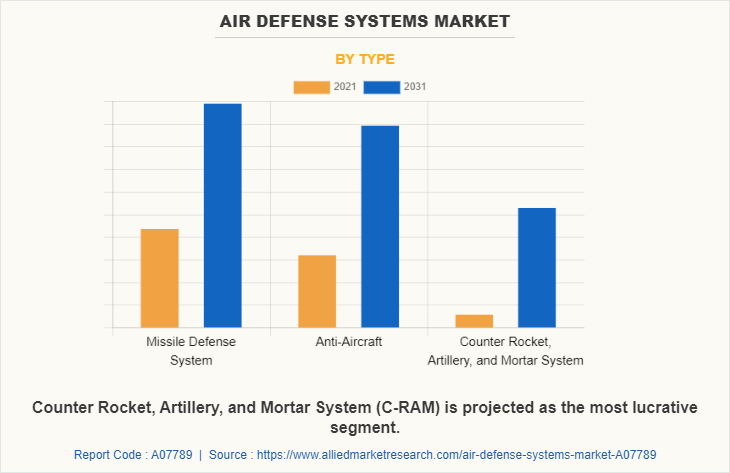
Companies have adopted product development and product launch as their key development strategies in the air defnse system industry. Moreover, collaborations and acquisitions are expected to enable leading players to enhance their product portfolios and expand into different regions. The key players operating in the air defense system market are Saab AB, Lockheed Martin Corporation, BAE Systems PLC, Rheinmetall AG, Thales Group, Kongsberg Gruppen, Raytheon Technologies, MBDA, Northrop Grumman Corporation, Boeing, Hanwha Corporation, Leonardo S.P.A., Airbus Defense and Space, Aselsan A.S., Elbit Systems, and General Dynamics.
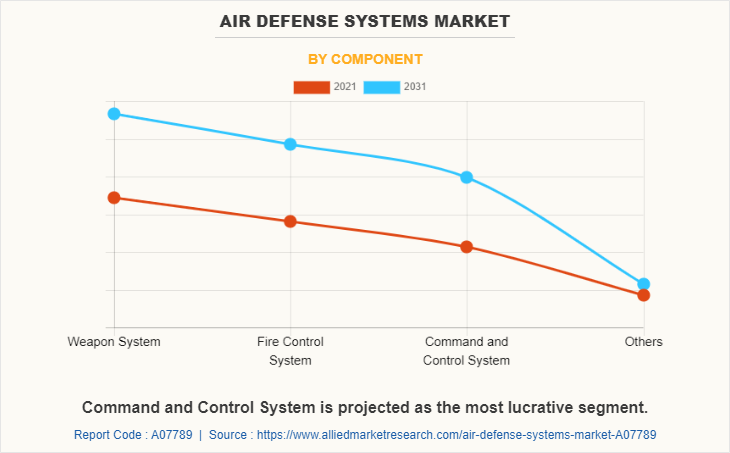
Increasing defense programs of nations to protect against various threats
The capacity to protect a nation's air space has grown more crucial as air combat technologies have developed, coupled with increased terrorism and cross border conflicts. The force is shielded from enemy air and missile attack by the air defense system. The effectiveness of the U.S. weapon systems aids the nation in guaranteeing that the U.S. military has a tactical fighting edge over any foe. For instance, the U.S, Department of Defense (DoD) requested $247.3 billion for acquisition (Procurement and Research, Development, Test, and Evaluation (RDT&E)) funding for 2020. This amount includes funding from the base budget and the overseas contingency operations (OCO) fund, which totals $143.1 billion for Procurement and $104.3 billion for RDT&E.
Increasing use of early warning systems for potential air and missile attacks
A variety of enemy airborne forces, including aircraft, unmanned aerial vehicles (UAVs), ballistic and cruise missiles, are monitored by air defence systems. For surveillance, these systems often employ long-range L-band radars and satellites. To fight modern ballistic and hypersonic missile threats, system designers are combining high-performance radar, electro-optical sensors, and the most recent digital signal processing on land and in space. To help Polish military officials deal with ambiguous intelligence about prospective air and missile assaults, the Polish government awarded Northrop Grumman Corporation a contract for $350 million in March 2019. The contract calls for the development of two combat management systems.
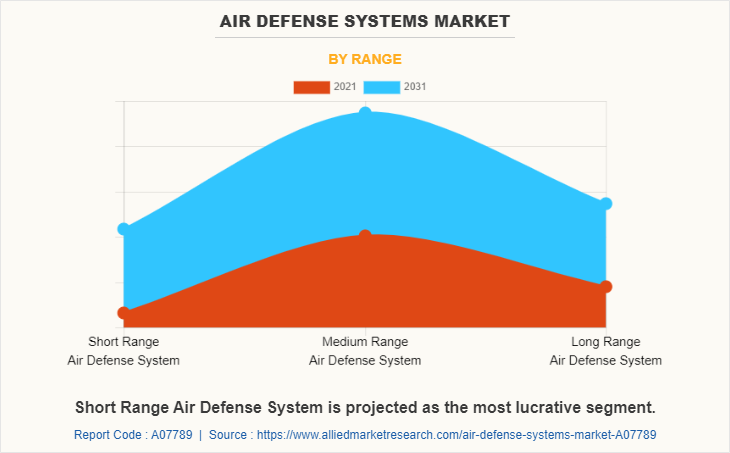
High cost associated to Air defense system
One of the major issues igniting the defense program was the expense of the air defense system. High cost associated with integration and implementation of air defense systems is limiting several nations to undergo long-term acquisition and operation contract. However, these nations practice acquisition and operation of second-hand air defense system, which are scrapped by first world nations. Excluding the cost of manufacturing and constructing nuclear weapons, the U.S. Army successfully designed and then installed the safeguard anti-ballistic missile (ABM) system in North Dakota for $23 billion in 2000. The goal of the Safeguard ABM system is to defend an ICBM launch area against Soviet attack in the form of a retaliatory strike. The system was completely compliant with the ABM Treaty as well as the current consensus strategic approach. However, it only lasted for four months when the U.S. Department of Defense decided to shut it down because running it was too expensive, considering what was eventually thought to be its minimal value to the U.S. security.
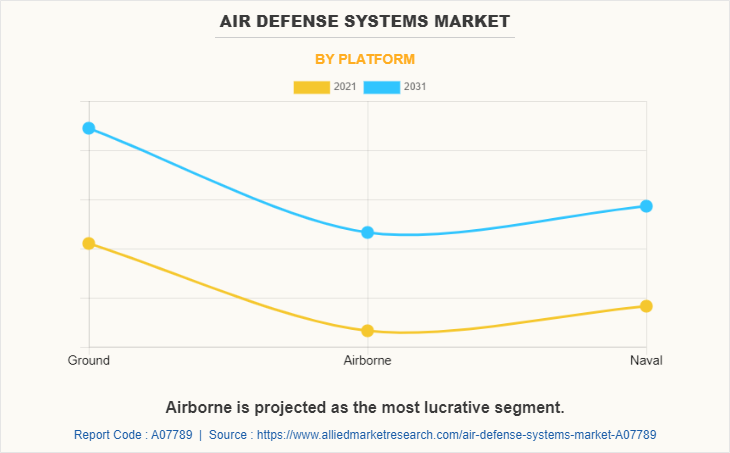
Development of new-generation air and missile defense systems
Technology superiority is increasingly going to be the decisive factor in future battles. The development of new-generation missiles with high-end technologies is a major threat to strategic locations and platforms, such as military airbases and ships. Some of these new developments include, nuclear-capable ballistic missiles and high-speed cruise missiles. Various countries are developing such advanced weapons that are capable of defeating high-end air defense systems, such as the Medium Extended Air Defense System (MEADS), the patriot advanced capability-3 (PAC-3), and the S-400.
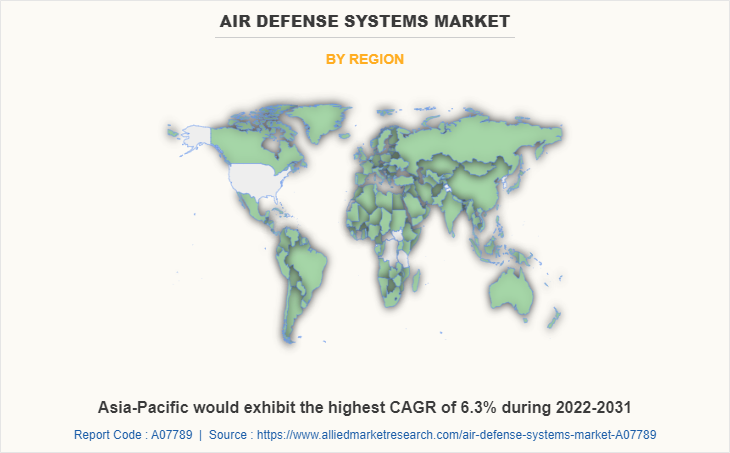
Key Benefits For Stakeholders
- This report provides a quantitative analysis of the air defense systems market segments, current trends, estimations, and dynamics of the air defense systems market analysis from 2021 to 2031 to identify the prevailing air defense systems market opportunities.
- The air defense systems market research is offered along with information related to key drivers, restraints, and opportunities.
- Porter's five forces analysis highlights the potency of buyers and suppliers to enable stakeholders make profit-oriented business decisions and strengthen their supplier-buyer network.
- In-depth analysis of the air defense systems market segmentation assists to determine the prevailing air defense systems market opportunities.
- Major countries in each region are mapped according to their revenue contribution to the global air defense systems market.
- Market player positioning facilitates benchmarking and provides a clear understanding of the present position of the air defense systems market players.
- The report includes the analysis of the regional as well as global air defense systems market trends, key players, market segments, application areas, and air defense systems market growth strategies.
Air Defense Systems Market Report Highlights
| Aspects | Details |
| Market Size By 2031 | USD 78.2 billion |
| Growth Rate | CAGR of 5.6% |
| Forecast period | 2021 - 2031 |
| Report Pages | 345 |
| By Type |
|
| By Component |
|
| By Range |
|
| By Platform |
|
| By Region |
|
| Key Market Players | MBDA, Lockheed Martin Corporation, General Dynamics, Thales Group, Boeing, Elbit Systems, Northrop Grumman Corporation, Rheinmetall AG, Kongsberg Gruppen, Leonardo S.P.A., Hanwha Corporation, BAE Systems PLC, Airbus Defense and Space, L3Harris Technologies, Saab AB, Raytheon Technologies |
Analyst Review
The air defense system market is expected to witness a significant growth rate owning to increase in defense budgets of nations across the globe and rising concerns of nations to protect themselves from conventional and modern threats. While the deployment of air defense systems is costly and requires large capital spending for its integration in a variety of platforms, increase in defense expenditure facilitates the implementation of expensive yet necessary missile defense system technologies. Furthermore, advancements of weapons and attacking capabilities globally have created the demand for modernization and installation of sophisticated defense technologies by governments to prevent threats and offensive attacks from foreign countries. Hence, increase in defense expenditure is expected to open new avenues for the growth of the air defense system market during the forecast period.
Also, adoption of internet of things (IoT) within the air defense system market is expected to change the business dynamics during the forecast period. One of the popular air defense systems is the Iron Dome. It is an artificial intelligence (AI)-powered anti-missile system that is reportedly 90% effective. The Iron Dome employs artificial intelligence to decide if the approaching wave of short-range rockets and missiles will strike the common people or the state's important assets. Unmanned Aerial Vehicles (UAVs), guided missiles, and cruise missiles are among the threats that the AI system identifies, analyzes, and ultimately obstructs. In addition, AI and machine learning (ML) could also be useful in analyzing a vast amount of missile testing-data. A typical testing of ground-based midcourse defense generates terabytes of data. Using AI can ease the processing of data and provide vital insights to improve the functioning of the missile defense system.
To fulfill the changing demand scenarios, market participants are concentrating on product launches to offer a diverse range of products and meet new business opportunities. In addition, market participants are continuously focusing on contracts and partnership efforts to match changing end-user requirements and improve the growth of the air defense system market.
Among the analyzed regions, North America is the highest revenue contributor, followed by Europe, Asia-Pacific, and LAMEA. Asia-Pacific is expected to witness highest growth rate during the forecast period, owing to increasing efforts of the Indian and Chinese governments to develop indigenous defense manufacturing infrastructure.
The global air defense system market was valued at $46,197.4 million in 2021, and is projected to reach $78,194.0 million by 2031, registering a CAGR of 5.6% from 2022 to 2031.
The key players operating in the market are Saab AB, Lockheed Martin Corporation, BAE Systems PLC, Rheinmetall AG, Thales Group, Kongsberg Gruppen, Raytheon Technologies, MBDA, Northrop Grumman Corporation, Boeing, Hanwha Corporation, Leonardo S.P.A., Airbus Defense and Space, Aselsan A.S., Elbit Systems, and General Dynamics.
North America is the largest regional market for air defense system
Intercepting incoming aerial threats such as missiles, drones, or other aerial ammunition are among the major application of air defense system.
Integration of new systems and upgradation of existing air defense systems to improve interception rates are some of the major market trends.
Loading Table Of Content...



